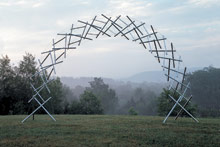Public sculpture has long played a role in Asheville’s ability to market itself to art-loving tourists. From Dirck Cruser’s “Energy Loop” (currently being restored) to the newly installed aluminum “Deco Gecko,” and from the various works on the Urban Trail to Albert Paley’s “Passage” in front of the Federal Building, sculpture seems to be everywhere.

And thanks to efforts like the RiverSculpture Festival, we can expect that three-dimensional art will continue to be in for some time.
In 1948, however, public outdoor sculptures were definitely out. There don’t appear to have been many here, and what few there were—such as the Vance Memorial—were holdovers from an earlier era. So when a young man named Kenneth Snelson arrived at Black Mountain College to study design with Joseph Albers and architecture with Buckminster Fuller, chances are he wasn’t impressed by what he found.
Shortly after his first visit to the school, Snelson created a small table-top sculpture, known today as the “Early X Piece.” It would be the first significant work of Snelson’s to focus on ideas of compression and tension to provide structural integrity—a concept now called “tensegrity.” When he later returned to the school, tensegrity became the primary focus of his projects—and a strong influence on others working there, including Fuller.
Snelson’s works are highly valuable today, appearing in far-flung collections all over the globe. Now a spry 81, the artist will be returning to the Asheville area to talk about his ideas and how they relate to both art and science.
Sculpture and the nature of structure will make up a large part of Snelson’s presentation, but the talk won’t be limited to the topic. He has mentioned, for instance, that his other artistic pursuit—panoramic photos—will also be discussed, as will his multimedia, open-ended work “Portrait of an Atom.”
According to Diane Ruggiero, Asheville’s superintendent of cultural arts, her announcement that Snelson would be speaking in Asheville caused quite a stir at the recent Americans for the Arts Conference in Philadelphia.
“His visit is important not just because he has ties to the Black Mountain College, but because of his approach to public art,” she says. “He will be a tough act to follow.”
As it turns out, Snelson’s work was influential to at least one local artist. The creator of the previously mentioned “Deco Gecko,” Harry McDaniel, remembers seeing the 60-foot high “Needle Tower” at the Hirshhorn Museum and Sculpture Garden when he was a child.
“I’ve been intrigued by his work ever since,” McDaniel says. “Nobody else can do what he does.”
Another local who’s been impacted by Snelson’s work is Dana Irwin, a member of Asheville’s Public Art Board (a co-sponsor of Snelson’s visit). “Going to the Hirshhorn to see the ‘Needle Tower’ has always been like a pilgrimage for me,” Irwin says. “I never went to D.C. without going to see that sculpture out of a pure love of art. It just takes off, right into the sky! I’m fascinated by his scientific mind and how he translates science and mathematics into his art.”
Of course, not everyone is enamored with Snelson’s work: His geometric shapes and lines have been called too harsh and industrial. But no one would dare call these stunning works banal—an accusation that has been leveled at many prominent outdoor pieces in Asheville that seem to exist solely to give local tourists something to pose with.
When local sculptors seek inspiration, they generally look to someone like Snelson. His intellectual process and use of negative space are the things that another local sculpture lover, Arlene Winkler, finds fascinating about his work. Winkler, who with her husband Robert instituted the RiverSculpture Festival, remarks that “having an artist of Snelson’s caliber visit Asheville will raise the level of dialogue about art in general and about public sculpture in particular.”
[Connie Bostic is an Asheville-based painter and writer.]
who: “Kenneth Snelson, In Person” presented by Black Mountain College Museum + Arts Center
what: Groundbreaking American sculptor
where: Fine Arts Theatre (36 Biltmore Ave.)
when: Tuesday, July 22 (7:30 p.m. $10, $8 BMCM+AC members.www.blackmountaincollege.org or 350-8484)



Before you comment
The comments section is here to provide a platform for civil dialogue on the issues we face together as a local community. Xpress is committed to offering this platform for all voices, but when the tone of the discussion gets nasty or strays off topic, we believe many people choose not to participate. Xpress editors are determined to moderate comments to ensure a constructive interchange is maintained. All comments judged not to be in keeping with the spirit of civil discourse will be removed and repeat violators will be banned. See here for our terms of service. Thank you for being part of this effort to promote respectful discussion.